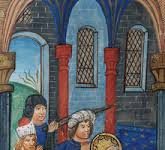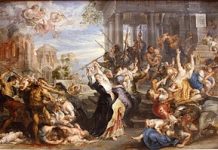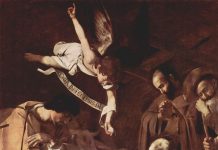It is commonly acknowledged that the first Capuchin saint, Felice da Cantalice, gave a powerful dose of humility, poverty and joy to Capuchin holiness. In fact, for many lay friars he was the fixed ideal model of what it means to lead a holy Capuchin life. This was also the journey which led Giacomo Amoroso from Nicosia, in the fertile land of Sicily.
His life story narrates that at twenty eight he started his novitiate in our friary in Mistretta, in 1743. He also took not just the name but the character and example of the holy brother Felix who had been canonised around thirty years before his entrance in the Order. Felice’s vocational path was challenging even though he spent his youth in a life of outstanding virtue. His parents, Filippo Amoroso and Carmela Pirro, to whom he was born on 5th of November 1715, raised a large family in poor conditions. However, the Amoroso family were abundantly prosperous in the fear of God and unshakeable Christian foundations.
The father of Giacomo Antonio Amoruso (the later Br Felice) worked as a cobbler in a poorly lit cubby-hole and barely managed to survive. Thus he earnestly wished his son to become expert in this trade. As a result, as Giacomo grew up Filippo immediately entrusted him to the most famous shoe-shop in the city. This shop, full of workers, was administered by Giovanni Ciavarelli. At this Giacomo became an expert in the trade of shoe making. When he sat in silence at his table to work, he exuded seriousness, respect and devotion among his fellow workers. Despite his young age his fervent faith not only connected him with the pious society of Cappuccinelli, under the friary of Nicosia, but he was enrolled and consequently put on the cape of its members with a small Franciscan cowl. With zest he felt himself being changed by Capuchin spirituality which he lived out in every action he did as well as during his work.
A witness, who worked as a colleague in the shoe-shop, narrated how when Giacomo entered the work-shop he used to take off his hat and then greet everyone, saying: ‘In every hour and every moment, may the Most Blessed Sacrament always be praised.’ He always had his head covered because he said that God is everywhere and it is necessary to stay in his presence with reverence, respect and veneration. If someone teased him he normally retorted Let it be for the love of God – a refrain that was to be his total life program. Being a “cappuccinello”, whenever he heard the bell ring in the Capuchin friary of the vicinity, he knelt down devoutly, prayed and invited the others, Compline is ringing. Servants of God, let us pray the holy rosary to the Blessed Virgin.
Although he was fit for the Capuchin life, Giacomo Antonio had to wait many years. After hearing the call to be a Capuchin he knocked at the door of the friary, and requested to be accepted as a simple lay friar. Nevertheless Giacomo always received no as an answer since the poverty of his family demanded his working contribution for its survival. As soon as both of his parents died Giacomo went to ask again to be admitted. Now, with his life situation changed, it was easier for the new Capuchin provincial, Br. Bonaventure da Alcara, who was in Nicosia on visitation, to accept. It was only after some ten years of waiting that this simple man of great faith, this “cappuccinello” could finally realize his wish of becoming a fully-fledged Capuchin friar.
He took the religious name of Felice da Nicosia. Bro Felice was adamant to walk the same path of holiness trailed by St Felice da Cantalice. The more one delves deeper in his life the more one notices some great God-coincidences which took place and ran parallel with St Felice da Cantalice’s life. Hence, his novitiate started at twenty eight years of age; he professed at twenty nine years; he was questor for forty three years in the city of his birth, Nicosia – like St Felice in Rome – and he died at seventy two years of age. A widely read biography by Icilio Felici defined him as the Bisaccia eroica (heroic saddlebag).
His life is marked by an impressive simplicity. Following the novitiate year in Mistretta, Brother Felice was sent to his city of Nicosia where he spent his life as a questor for his remaining years. In the city his holy presence left a deep imprint in the population. This accounts for his long stay in the friary of Colle in Nicosia, something very uncommon in the Order. Br Felix gladly accepted any sort of work given to him, being a questor, doorman, gardener, shoe-maker, nurse. He managed to extend his questing beyond the city of his birth and went into neighbouring regions such as Capizzi, Cerami, Gagliano, Mistretta and others. Br Felix walked from house to house, recollected and mortified, with the rosary in his hand and, as one witness said, with his eyes shut tight as if he were within a cave, always in silence. When I looked at him he always seemed to be recollected in God. Everyone was accustomed with the joyful gratitude of Br Felix. He used to say: Let it be for the love of God. In charming words he depicted himself as ‘the friary’s little donkey’ who after the questing came home with his load like the Sicilian carters.
On his way he taught the children the basic of the catechism, attracting their attention by sharing with them bread and beans. Br Felix was a practical teacher. From the pockets of his habit, he used to take little gifts for the hungry, bedraggled children: one nut, three nuts, five beans, ten chickpeas – to teach the children concerning the one God in three persons, the five wounds of the crucified Jesus and God’s Ten Commandments. Little gifts and kindness concretized the faith. Like Felice da Cantalice on the streets of Rome, he furthermore instructed little songs written on prayers, or the practice of theological virtues.
When he came across the poor who were carrying wood or other heavy loads he gladly and generously offered his help. Nonetheless, each suffering found in Br Felix a great caring man of God. He would do everything lest help alleviate the suffering of the needy. Br Felix was always available to serve the sick, twenty four hours around the clock. Every Sunday he paid visits to prisoners in jail and took them bread. His superior and confessor Br Macario da Nicosia confirmed that Br Felice “helped everyone, and as much as he could tried to put everything in order in things both spiritual and temporal. He kept bread and meat and other things to give to the needy. If obedience permitted, he would have taken it from his own mouth. He went here and there asking clothes and help from the well-off in order to clothe and help everyone. When he could not help he became quite anguished.
In twenty three years, his superior, who was his spiritual director, treated him badly. Just imagine the reproaches and nicknames he invented for the specific purpose to humiliate Br Felice. He called him lazybones, hypocrite, people-cheater, fra Scuntentu and so forth. Br Felice’s reply to these abusive words was simply this refrain: Let it be for the love of God. Many were the times when Brother Felice acted as the jester in the middle of the refectory with improvised carnival clothing. On one instance he had to pretend to distribute out very costly ricotta from a paste of ashes in a wicker basket on his head. The story goes that miraculously it had become real, fresh ricotta, much to the amazement of the friars and the irritation of the superior.
Br Felice was illiterate. His devotion was simple, his words were concrete, not intellectual at all. He fell in love with the Eucharist, Our Lady of Sorrows and Jesus crucified. The sacristan of the Nicosia friary, Br Francesco Gangi, had the following fond memory of Br Felice: He always told me and encouraged me to learn to do mental prayer, specially that based on passion of Jesus Christ. He told me that the one who meditates on and thinks about the passion of Jesus Christ will not suffer the pains of hell. And he told me this with such heartfelt fervour that he was weeping. Because of my task as sacristan I often had occasion to meet him. Weeping, he would embrace me and told me to pray over the passion of Jesus Christ.
Br Felice’s faith was candid. As an infallible remedy for every evil he used his “polize” of Our Lady, cut strips of paper printed with devout invocations to the Blessed Virgin written in both Sicilian and Latin. Br Felice kept them in the pockets of his habit and gladly shared them around. Also, he hung them on the doors of houses where there were sick or poor people or on the barrels from which he received alms of wine. He threw them into a fire that had attacked sheaths waiting for threshing, or into some grain blackened by natural disaster, or into a dry, cracked cistern. His life story says that several graces and miracles occurred, often real pranks of Providence.
When his health finally deteriorated, due to his extreme penance and mortification, Br Felice kept giving by making himself available to any kind of service, particularly towards the sick in the friary infirmary. At seventy two years of age, exhausted due to his harsh life of extremely generous service, Br Felice’s focus on God flourished, coupled with his happy and simple obedience. At this time Br Felice embodied in himself obedience as an act of pure love. This was his final and special message. At the end of May 1787, u sciccareddu – the little donkey of the friary, having gone down to the cloister to tend to the medicinal herbs that he cultivated for the sick, he collapsed onto the flowers in the garden. Brought into his own little bed, having received the sacraments and commending himself to the mani ‘nchiuvati (nailed hands), that is, Father Saint Francis, he frequently invoked Our Mother Mary. On Friday 31 May he requested his superior obedience to die. When after his third request he got the permission, radiant in his happy smile, with his last breath, Br Felice said, Let it be for the love of God. Then bowing his head, Br Felice bid his final farewell and slept the sleep of eternal rest.
Our Capuchin Order started his cause of beatification on 10 July 1828. The apostolic process in Nicosia finished its proceedings on 12 July 1848. Pius XI proclaimed his heroic virtue on 4 March 1862. Pope Leo XIII declared him blessed on 12 February 1888. In 1864, after the suppression of the friary in Nicosia, his body was transferred to the Cathedral in May 1885 and to the new Capuchin church in 1895. It was Pope Emeritus Benedict XVI who, on October 23, 2005, added him in the list of the canonized.
In the homily of his canonization, on October 23, 2005, World Mission Sunday and also the conclusion of the 11th ordinary general assembly of the Synod of Bishops and Year of the Eucharist, Pope Emeritus Benedict XVI said on Blessed Felice da Nicosia:
St Felix of Nicosia loved to repeat in all situations, joyful or sad: “So be it, for the love of God”. In this way we can well understand how intense and concrete his experience was of the love of God, revealed to humankind in Christ. This humble Capuchin Friar, illustrious son of the land of Sicily, austere and penitent, faithful to the most genuine expressions of the Franciscan tradition, was gradually shaped and transformed by God’s love, lived and carried out in love of neighbour. Bro. Felix helps us to discover the value of the little things that make our lives more precious, and teaches us to understand the meaning of family and of service to our brothers and sisters, showing us that true and lasting joy, for which every human heart yearns, is the fruit of love.
Father, you recognise the humility of your servant Saint Felix of Nicosia and revealed to him the mysteries of your Kingdom; listen to your beloved Son, meek and humble of heart, that we may be counted among the little ones of the Gospel and radiate throughout the world the light of your wisdom. Through our Lord Jesus Christ, your Son, who lives and reigns with you, in the unity of the Holy Spirit, God, for ever and ever. Amen.











